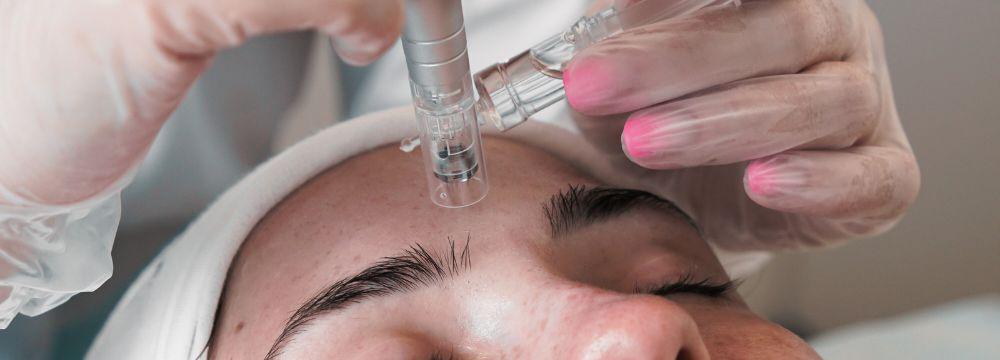Microneedling – Effective for Rejuvenation?

Percutaneous collagen induction therapy is the medical term for microneedling, an approach for treating various skin issues by harnessing the body’s natural healing properties. During microneedling, tiny needles penetrate the dermis and remodel the skin’s texture. As the skin heals from this controlled, careful, and uniform puncturing, it generates collagen and new skin cells. Its popularity is due to its simplicity, noticeable results, and relative affordability. Varying improvements in the visibility of scars and keloids, skin firmness, and stretch marks are seen with this treatment, not to mention the improvement of enlarged pores and wrinkles with minimal concern for skin discoloration.
That said, microneedling takes a similar approach to how some lasers work. Besides tightening the skin, reducing pores, and improving texture visibly, microneedling can address stretch marks on the hips and abdomen, which is a challenging condition with limited therapeutic options. Wrinkles and surgical scars are also excellent targets for treatment with extended penetration depths since the dermal restructuring softens their appearance.
During your free consultation, you can speak to Dr. Boger about a more extensive facial skincare routine and how microneedling fits into the treatment program. Qualified medical specialists can use microneedling devices that penetrate the skin up to 3 mm, far deeper than a facial or microdermabrasion. However, we will likely start with a smaller needle size and work our way up. This is done because, as with any treatment that punctures the skin, there is a small chance for scarring the deeper we go.
The Home Remedy Option
The standard depth for at-home-style rollers can vary and starts at a fraction of a millimeter. Puncturing the stratum corneum (outer layer of skin) and upper epidermis is a great way to stimulate skin turnover. However, you should minimize needle length to avoid potential infection or scarring. You must be cautious if you plan to use products after your microneedling. For example, vitamin C can cause irritation and even granuloma formation – inflammatory nodules — when used with microneedling. However, other products can be helpful. This can include hyaluronic acid serums and gentle, fragrance-free moisturizers. By channeling the product deeper into the skin, some products can have a more substantial effect than if only applied to the surface.
Minimal risks of irritation aside, this is an easy and affordable way to experience some of the benefits of microneedling at home. That said, does home microneedling work? This may be an option for some; however, they will not receive the collagen-stimulating benefit we offer in-office at Revive. We always suggest speaking to your doctor before attempting any home remedy that punctures the skin.
Technological Evolution
Original microneedle designs resembled a stamp; however, we use an electric pen-type design today, where the depth can be controlled, and small areas are treated with each deployment. These create deeper channels than any at-home roller or spa treatment can. As a result, you may need a topical numbing agent to minimize discomfort. You may also require prophylactic oral antiviral therapy if you have certain conditions like cold sores. Although results might be seen after a single treatment, microneedling typically requires several sessions for full effect. Healing can take 4-6 weeks, and therapies should not be repeated too soon.
Post-procedure
You should expect discomfort and swelling; deeper treatments may require basic wound care. Be sure to clean anything touching your face, including pillowcases, and follow post-procedure instructions on washing your face and applying ointments and creams. Microneedling is an excellent option for darker skin types, and hyperpigmentation after treatment is very rare. However, when it does occur, it is usually the result of UV exposure, so sunscreen is essential.
Talk to Dr. Boger if you have acne, sensitive skin, cold sores, tend to develop keloids, or had recent tox injections. These could cause unwanted issues if not properly planned or overseen. Prepare for your skin to appear swollen and red for a few days, and you should not schedule any outdoor activities immediately following treatments. You may experience skin darkening followed by peeling for up to two weeks.
RF Microneedling
Newer microneedling devices like our Potenza therapy incorporate radio frequency (RF) to enhance the microdamage to the skin. This combination may bolster collagen production and help patients enjoy faster results with fewer visits.
The Bottom Line
Microneedling is a tried-and-true way to rejuvenate your skin’s appearance. It can be an excellent option for those trying to treat more challenging conditions. Used in conjunction with thoughtful home care, a proper moisturizing regimen, and some of the maintenance skin care procedures we offer, like facials and microdermabrasion, microneedling provides fantastic results. For more significant damage, we have advanced laser-based therapies to reverse some of the damage. We encourage you to contact our office and schedule a free consultation with Dr. Boger. You’ll learn more about how this and other skin care treatments to help regain – or maintain – that youthful look.